语言学导论第6章Pragmatics
- 格式:ppt
- 大小:313.50 KB
- 文档页数:26
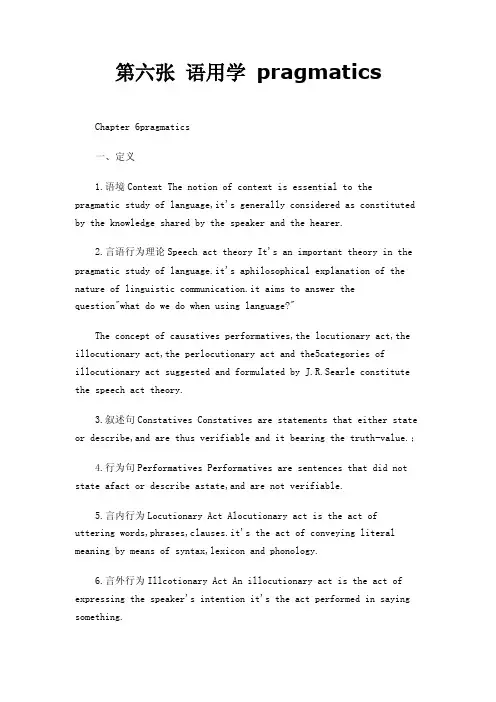
第六张语用学pragmatics Chapter 6pragmatics一、定义1.语境Context The notion of context is essential to the pragmatic study of language,it's generally considered as constituted by the knowledge shared by the speaker and the hearer.2.言语行为理论Speech act theory It's an important theory in the pragmatic study of language.it's aphilosophical explanation of the nature of linguistic communication.it aims to answer the question"what do we do when using language?"The concept of causatives performatives,the locutionary act,the illocutionary act,the perlocutionary act and the5categories of illocutionary act suggested and formulated by J.R.Searle constitute the speech act theory.3.叙述句Constatives Constatives are statements that either state or describe,and are thus verifiable and it bearing the truth-value.;4.行为句Performatives Performatives are sentences that did not state afact or describe astate,and are not verifiable.5.言内行为Locutionary Act Alocutionary act is the act ofuttering words,phrases,clauses.it's the act of conveying literal meaning by means of syntax,lexicon and phonology.6.言外行为Illcotionary Act An illocutionary act is the act of expressing the speaker's intention it's the act performed in saying something.7.言后行为Perlocutionary Act Perlocuationary Act is the act performed by or resulting from saying something.it's the consequence of,or the change brought about by the utterance.8.句子意义Sentence meaning It refers to asentence and is agrammatical concept,the meaning of asentence is often studied as the abstract intrinsic property of the sentence itself in terms of predication.9.话语意义Utterance meaning It refers to asentence as what people actually utter in the course of communication,it becomes and utterance and it should be considered in the situation in which it is actually uttered.10.合作原则Cooperative Principle It's proposed and formulated by P.Grice,a pragmatic hypothesis,is about that the participants must first of all be willing to cooperate,otherwise,it would not be possible for them to carry on the talk.11.会话含义Conversational implicatures According to P.Grice,it refers to the extra meaning not contained in thutterance,understandable to the listener only when he shares the speaker's knowledge or knows why and how he violates intentionally one of the four maxims of the CP.话语的言外之义是说话人通过故意违反某一准则而获得这种听者能懂的暗含之意。
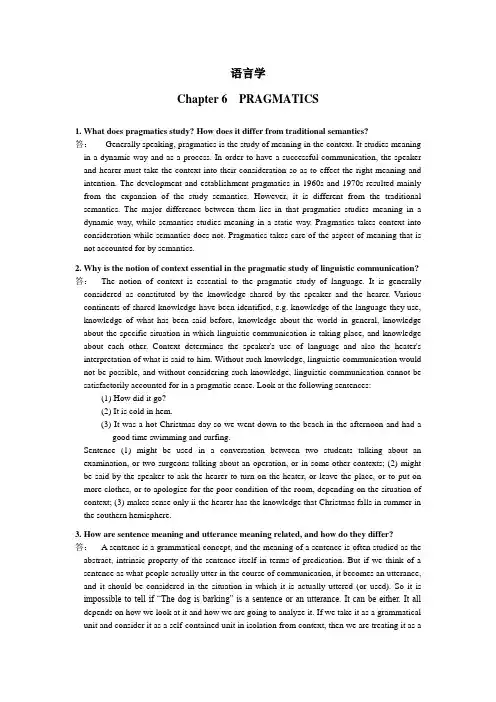
语言学Chapter 6 PRAGMATICS1. What does pragmatics study? How does it differ from traditional semantics?答:Generally speaking, pragmatics is the study of meaning in the context. It studies meaning in a dynamic way and as a process. In order to have a successful communication, the speaker and hearer must take the context into their consideration so as to effect the right meaning and intention. The development and establishment pragmatics in 1960s and 1970s resulted mainly from the expansion of the study semantics. However, it is different from the traditional semantics. The major difference between them lies in that pragmatics studies meaning in a dynamic way, while semantics studies meaning in a static way. Pragmatics takes context into consideration while semantics does not. Pragmatics takes care of the aspect of meaning that is not accounted for by semantics.2. Why is the notion of context essential in the pragmatic study of linguistic communication? 答:The notion of context is essential to the pragmatic study of language. It is generally considered as constituted by the knowledge shared by the speaker and the hearer. Various continents of shared knowledge have been identified, e.g. knowledge of the language they use, knowledge of what has been said before, knowledge about the world in general, knowledge about the specific situation in which linguistic communication is taking place, and knowledge about each other. Context determines the speaker's use of language and also the heater's interpretation of what is said to him. Without such knowledge, linguistic communication would not be possible, and without considering such knowledge, linguistic communication cannot be satisfactorily accounted for in a pragmatic sense. Look at the following sentences:(1) How did it go?(2) It is cold in hem.(3) It was a hot Christmas day so we went down to the beach in the afternoon and had agood time swimming and surfing.Sentence (1) might be used in a conversation between two students talking about an examination, or two surgeons talking about an operation, or in some other contexts; (2) might be said by the speaker to ask the hearer to turn on the heater, or leave the place, or to put on more clothes, or to apologize for the poor condition of the room, depending on the situation of context; (3) makes sense only ii the hearer has the knowledge that Christmas falls in summer in the southern hemisphere.3. How are sentence meaning and utterance meaning related, and how do they differ?答: A sentence is a grammatical concept, and the meaning of a sentence is often studied as the abstract, intrinsic property of the sentence itself in terms of predication. But if we think of a sentence as what people actually utter in the course of communication, it becomes an utterance, and it should be considered in the situation in which it is actually uttered (or used). So it is impossible to tell if “The dog is barking” is a sentence or an utterance. It can be either. It all depends on how we look at it and how we are going to analyze it. If we take it as a grammatical unit and consider it as a self-contained unit in isolation from context, then we are treating it as asentence. If we take it as something a speaker utters in a certain situation with a certain purpose, then we are treating it as an utterance.Therefore, while the meaning of a sentence is abstract, and decontextualized, that of an utterance is concrete, and context-dependent. The meaning of an utterance is based on sentence meaning; it is the realization of the abstract meaning of a sentence in a real situation of communication, or simply in a context. Now, take the sentence "My bag is heavy" as an example. Semantic analysis of the meaning of the sentence results in the one-place predication BAG (BEING HEA VY). Then a pragmatic analysis of the utterance meaning of the .sentence varies with the context in which it is uttered. For example, it could be uttered by a speaker as a straightforward statement, telling the hearer that his bag is heavy. It could also be intended by the speaker as an indirect, polite request, asking the hearer to help him carry the bag. Another possibility is that the speaker is declining someone's request for help. All these are possible interpretations of the same utterance “M y bag is heavy”. How it is to be underst ood depends on the context in which it is uttered and the purpose for which the speaker utters it.While most utterances take the form of grammatically complete sentences, some utterances do not, and some cannot even be restored to complete sentences.4. Try to think of contexts in which the following sentences can be used for other purposes than just stating facts:a) The room is messy.b) Oh, it is raining!c) The music of the movie is good.d) You have been keeping my notes for a whole week now.答:a) A father entered his son’s room and found it is very messy. Then when he said, “The room is messy,” he was blaming his son for not tidying it up.b) A son asked his father to play with him outside. So when the father said, “Oh, it’s raining”,he meant they couldn’t play outside.c) Two persons just watched a movie and had a discussion of it. One person sai d, “The story ofthe movie is very moving”, so wh en the other person sai d, “The music of the movie is good”, he me ant he didn't think the story of the movie was good.d) A person wanted his notes bac k, so when he said, “you ha ve been keeping my notes for awhole wee k now”, he was demanding the return of his notes.5. According to Austin, what are the three acts a person is possibly performing while making an utterance. Give an example.答:According to Austin's new model, a speaker might be performing three acts simultaneously when speaking: locutionary act, illocutionary act, and perlocutionary act.A locutionary act is the act of uttering words, phrases, clauses. It is the act of conveying literal meaning by means of syntax, lexicon and phonology. An illocutionary act is the act of expressing the speaker’s intention; it is the act performed in saying something. A perlocutionary act is the act performed by or resulting from saying something; it is the consequence of, or the change brought about by the utterance; it is the act performed by saying something. Let's look at an example:You have left the door wide open.The locutionary act performed by the speaker is his utterance of the wo rds “you”, “have”,“door”, “open”, etc. thus expressing what the words literally mean.The illocutionary act performed by the speaker is that by making such an utterance he has expressed his intention of speaking, i.e. asking someone to close the door, or making a complaint, depending on the context.The perlocutionary act refers to the effect of the utterance. If the hearer gets the speaker's message and sees that the speaker means to tell him to close the door, the speaker has successfully brought about the change in the real world he has intended to; then the perlocutionary act is successfully performed.6. What are the five types of illocutionary speech acts Searle has specified? What is theillocutionary point of each type?答:(1) representatives: stating or describing, saying what the speaker believes to be true(2) directives: trying to get the hearer to do something(3) commissives: committing the speaker himself to some future course of action(4) expressives: expressing feelings or attitude towards an existing(5) declarations: bringing about immediate changes by saying somethingThe illocutionary point of the representatives is to commit the speaker to something's being the case, to the truth of what has been said, in other words, when performing an illocutionary act of representative, the speaker is making a statement or giving a description which he himself believes to be true. Stating, believing, sweating, hypothesizing are among the most typical of the representatives.Directives ate attempts by the speaker to get the hearer to do some- thing. Inviting, suggesting, requesting, advising, wanting, threatening and ordering are all specific instances of this class.Commissives are those illocutionary acts whose point is to commit the speaker to some future course of action, i.e. when speaking the speaker puts himself under a certain obligation. Promising, undertaking, vowing are the most typical ones.The illocutionary point of expressives is to express the psychological state specified in the utterance. The speaker is expressing his feelings or attitudes towards an existing state of affairs, e.g. apologizing, thanking, congratulating.The last class “declarations” has the characteristic that the successful performance of an act of this type brings about the correspondence between what is said and reality.7. What is indirect language use? How is it explained in the light of speech act theory?答:When someone is not saying I an explicit and straightforward manner what he means to say, rather he is trying to put across his message in an implicit, roundabout way, we can say he is using indirect language.Explanation (略) (见教材p.84-85)8. What are the four maxims of the CP? Try to give your own examples to show how floutingthese maxims gives rise to conversational implicature?答:Cooperative Principle, abbreviated as CP. It goes as follows:Make your conversational contribution such as required at the stage at which it occurs by the accepted purpose or direction of the talk exchange in which you are engaged.To be more specific, there are four maxims under this general principle:(1) The maxim of quantity①Make your contribution as informative as required (for the current purpose of theexchange).②Do not make your contribution more informative than is required.(2) The maxim of quality①Do not say what you believe to be false.②Do not say that for which you lack adequate evidence.(3) The maxim of relationBe relevant.(4) The maxim of manner①Avoid obscurity of expression.②Avoid ambiguity.③Be brief (avoid unnecessary prolixity).④Be orderly.9. What is pragmatic failure? Try to find instances of pragmatic failure in the English usedby Chinese learners of English.答:The technical term for breakdowns in the course of communication is pragmatic failure.Pragmatic failure occurs when the speaker fails to use language effectively to achieve a specific communication purpose, or when the hearer fails to recognize the intention or the illocutionary force of the speaker’s utterance in the context of communication.Instances (略) (见教材p.89)。

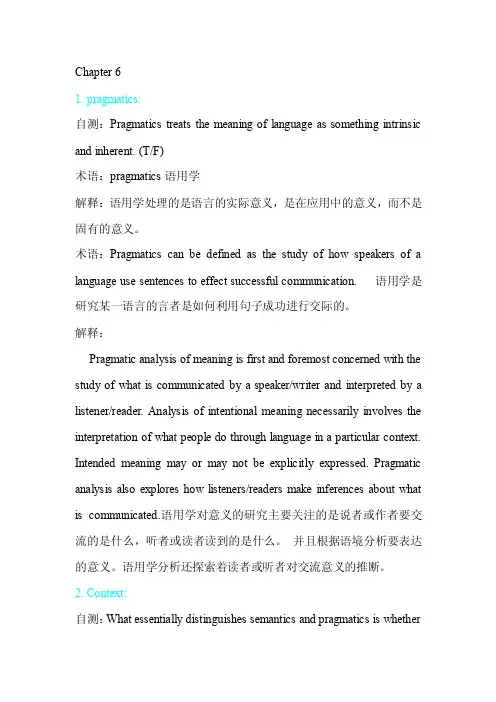
Chapter 61.pragmatics:自测:Pragmatics treats the meaning of language as something intrinsic and inherent. (T/F)术语:pragmatics语用学解释:语用学处理的是语言的实际意义,是在应用中的意义,而不是固有的意义。
术语:Pragmatics can be defined as the study of how speakers of a language use sentences to effect successful communication. 语用学是研究某一语言的言者是如何利用句子成功进行交际的。
解释:Pragmatic analysis of meaning is first and foremost concerned with the study of what is communicated by a speaker/writer and interpreted by a listener/reader. Analysis of intentional meaning necessarily involves the interpretation of what people do through language in a particular context. Intended meaning may or may not be explicitly expressed. Pragmatic analysis also explores how listeners/readers make inferences about what is communicated.语用学对意义的研究主要关注的是说者或作者要交流的是什么,听者或读者读到的是什么。
并且根据语境分析要表达的意义。

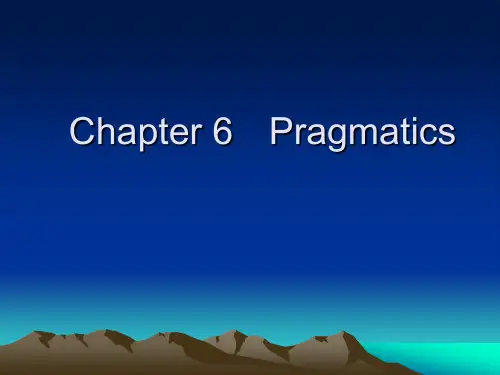

Chapter 6 Pragmatics6.1 Some basic notions6.1.1 Definition●—the study of language in use or language communication; the study of the use ofcontext to make inference about meaning.●—the study of how speakers of a language use sentences to effect successfulcommunication.Introduction●“Y ou are a fool.”●“What do you mean?”●Here are three aspects of the meaning of the sentences:SPEAKER’S MEANING,UTTERANCE MEANING,CONTEXTUAL MEANING●Depends more on the context●Pragmatics: The study of language in use●Pragmatics is usually concerned with the meanings that sentences have in particularcontexts in which they are used. E.g. There is a car coming is seen as, out of context, a statement that a car is coming. But in a particular context it might be a warning to a pedestrian not to step onto a road, an expression of hope that people invited to a dinner are at last arriving, and so on.语用学的开端语用学这个术语,是美国哲学家查尔斯·莫里斯首先使用的。
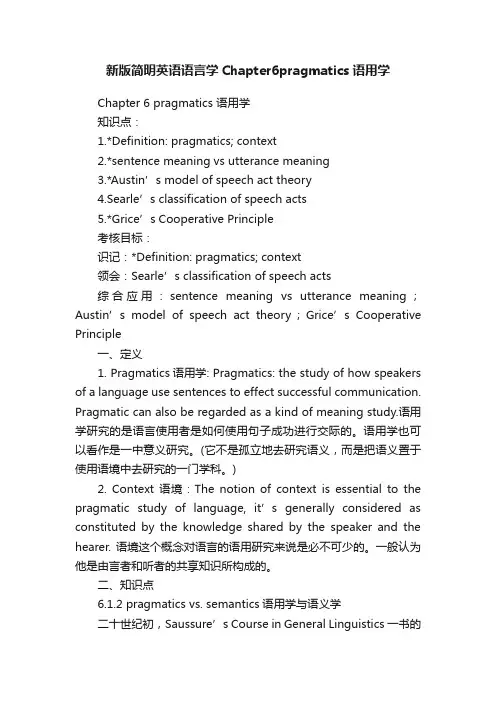
新版简明英语语言学Chapter6pragmatics语用学Chapter 6 pragmatics 语用学知识点:1.*Definition: pragmatics; context2.*sentence meaning vs utterance meaning3.*Austin’s model of speech act theory4.Searle’s classification of speech acts5.*Grice’s Cooperative Principle考核目标:识记:*Definition: pragmatics; context领会:Searle’s classification of speech acts综合应用:sentence meaning vs utterance meaning;Austin’s model of speech act theory;Grice’s Cooperative Principle一、定义1. Pragmatics语用学: Pragmatics: the study of how speakers of a language use sentences to effect successful communication. Pragmatic can also be regarded as a kind of meaning study.语用学研究的是语言使用者是如何使用句子成功进行交际的。
语用学也可以看作是一中意义研究。
(它不是孤立地去研究语义,而是把语义置于使用语境中去研究的一门学科。
)2. Context 语境:The notion of context is essential to the pragmatic study of language, it’s generally considered as constituted by the knowledge shared by the speaker and the hearer. 语境这个概念对语言的语用研究来说是必不可少的。

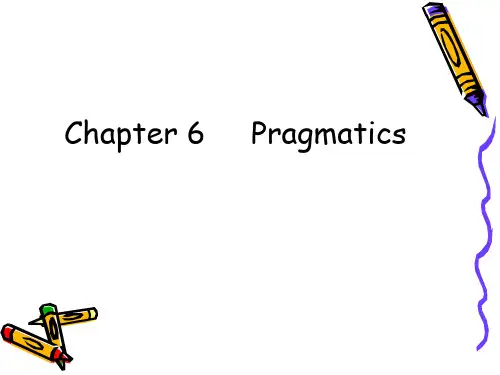
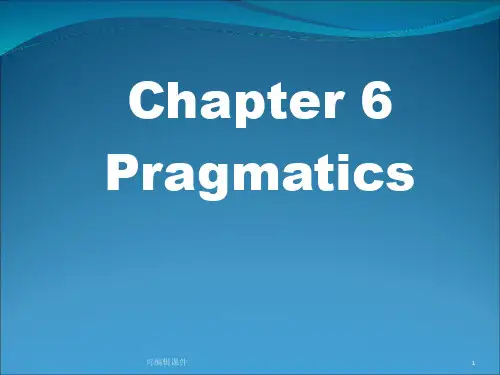
英语(yīnɡ yǔ)语言学概论第六章笔记Chapter 6 Pragmatics 语用学1.What is pragmatics?什么(shén me)是语用学?Pragmatics can be defined as the study of how speakers of a language use sentences to effect successful communication.As the process of communication is essentially a process of conveying meaning in a certain context, pragmatics can also be regarded as a kind of meaning study. It places the study of meaning in the context in which language is used.语用学研究(yánjiū)的是说某种语言的人怎样用句子去实现成功的交际。
由于交际的过程从本质来说是在一定的语境中表达意义的过程,因而语用学的本质是一种意义研究(yánjiū)。
它是一种将语言置于使用的语境中去的意义研究。
2.Pragmatics and semantics 语用学和语义学Pragmatics and semantics are both linguistic studies of meaning, but they are different. What essentially distinguishes semantics and pragmatics is whether in the study of meaning, the context of use is considered. If it is not considered, the study is restricted to the area of traditional semantics; if it is considered, the study is being carried out in the area of pragmatics.语用学和语义学都是对意义的语言学研究,但两者是不同(bù tónɡ)的。
(完整word版)chapter6pragmaticsChapter 6:PragmaticsI. Decide whether each of the following statements is True or False:1. Both semantics and pragmatics study how speakers of a language use sentences to effect successful communication2. Pragmatics treats the meaning of language as something intrinsic and inherent.3. It would be impossible to give an adequate description of meaning if the context of language use was left unconsidered.4. What essentially distinguishes semantics and pragmatics is whether in the study of meaning the context of use is considered.5. The major difference between a sentence and an utterance is that a sentence is not uttered while an utterance is.6. The meaning of a sentence is abstract, but context-dependent.7. The meaning of an utterance is decontexualized, therefore stable.8. Utterances always take the form of complete sentences9. Speech act theory was originated with the British philosopher John Searle.10. Speech act theory started in the late 50’s of the 20th century.11. Austin made the distinction between a constative and a performative.12. Perlocutionary act is the act of expressing the speaker’s intention.II. Fill in each blank below with one word which begins withthe letter given:13. P_________ is the study of how speakers of a language use sentences to effect successful communication.14. What essentially distinguishes s_______ and pragmatics is whether in the study of meaning the context of use is considered.15. The notion of c_________ is essential to the pragmatic study of language.16. If we think of a sentence as what people actually utter in the course of communication, it becomes an u___________.17. The meaning of a sentence is a_______, and decontextualized.18. C________ were statements that either state or describe, and were thus verifiable.19. P________ were sentences that did not state a fact or describe a state, and were not verifiable.20. A l_________ act is the act of uttering words, phrases, clauses. It is the act of conveying literal meaning by means of syntax, lexicon and phonology.21. An i__________ act is the act of expressing the speaker’s intention; it is the act performed in saying something.22. A c_________ is commit the speaker himself to some future course of action.23. An e________ is to express feelings or attitude towards an existing state.24. There are four maxims under the cooperative principle: the maxim of q_______, the maxim of quality, the maxim of relation and the maxim of manner.III. There are four choices following each statement. Mark the choice that can best complete the statement:25. _________ does not study meaning in isolation, but incontext.A. PragmaticsB. SemanticsC. Sense relationD. Concept26. The meaning of language was considered as something _______ in traditional semantics.A. contextualB. behaviouristicC. intrinsicD. logical27. What essentially distinguishes semantics and pragmatics is whether in the study of meaning _________ is considered.A. referenceB. speech actC. practical usageD. context28. A sentence is a _________ concept, and the meaning of a sentence is often studied in isolation.A. pragmaticB. grammaticalC. mentalD. conceptual29. If we think of a sentence as what people actually utter in the course of communication, it becomes a(n) _________.A. constativeB. directiveC. utteranceD. expressive30. Which of the following is true ?A. Utterances usually do not take the form of sentences.B. Some utterances cannot be restored to complete sentences.C. No utterances can take the form of sentences.D. All utterances can be restored to complete sentences.31. Speech act theory did not come into being until __________.A. in th e late 50’s of the 20the c enturyB. in the early 1950’sC. in the late 1960’sD. in the early 21st century.32. __________ is the act performed by or resulting from saying something; it is the consequence of, or the change brought about by the utterance.A. A locutionary actB. An illocutionary actC. A perlocutionary actD. A performative act33. According to Searle, the illocutionary point of the representative is ______.A. to get the hearer to do somethingB. to commit the speaker to something’s being the caseC. to commit the speaker to some future course of actionD. to express the feelings or attitude towards an existing state of affairs.34. All the acts that belong to the same category share the same purpose, but they differ __________.A. in their illocutionary actsB. in their intentions expressedC. in their strength or forceD. in their effect brought about35. __________ is advanced by Paul GriceA. Cooperative PrincipleB. Politeness PrincipleC. The General Principle of Universal GrammarD. Adjacency Principle36. When any of the maxims under the cooperative principle is flouted, _______ might arise.A. impolitenessB. contradictionsC. mutual understandingD. conversational implicaturesIV. Define the terms below:37. pragmatics 38. context 39. utterance meaning40. sentence meaning 41. constative 42. performative43. locutionary act 44. illocutionary act45. perlocutionary act 46. Cooperative PrincipleV. Answer the following questions as comprehensively as possible. Give examples for illustration if necessary:47. How are semantics and pragmatics different from each other ?48. How does a sentence differ from an utterance ?49. How does a sentence meaning differ from an utterance meaning?50. Discuss in detail the locutionary act, illocutionary act and perlocutionary act.51. Searle classified illocutionary act into five categories. Discuss each of them in detail with examples.52. What are the four maxims under the cooperative principle ?53. How does the flouting of the maxims give rise toconversational implicatures ?54. Which of the Conversational Maxims is beig violated in the following conversation.A: Is he a good teacher?B: He is a very handsome bachelor.55. What are the sameness and the difference between the following five utterances?(1)Will John leave the room? (2) John will leave the room.(3) John, leave the room. (4) Would that John left the room?(5) If John leaves the room, I will leave also.Chapter 6 PragmaticsI. Decide whether each of the following statements is True or False:l. F 2.F 3.T 4.T 5.F 6.F 7.F 8.F 9.F 10.T 11.T 12.FII. Fill in each blank below with one word which begins with the letter given:13. Pragmatics 14. semantics 15. context 16. utterance 17. abstract18.Constatives 19. Performatives 20. locutionary 21. illocutionary22. commissive 23. expressive 24. quantityIII. There are four choices following each statement. Mark the choice that can best complete the statement:25. A 26.C 27.D 28.B 29.C 30.B31.A 32.C 33.B 34.C 35. A 36.DIV. Define the terms below:37. pragmatics: Pragmatics can be defined as the study of how speakers of a language use sentences to effect successful communication.38. Context: Generally speaking, it consists of the knowledge that is shared by the speak-er and the hearer. The shared knowledge is of two types: the knowledge of the language they use, and the knowledge about the world, including the general knowledge about the world and the specific knowledge about the situ-ation in which linguistic communication is taking place.39. utterance meaning: the meaning of an utterance is concrete, andcontext-dependent. Utterance is based on sentence meaning; it is realization of the abstract meaning of a sentence in a real situation of communication, or simply in a context.40. sentence meaning: The meaning of a sentence is of-ten considered as the abstract, intrinsic property of the sentence itself in terms of a predication.41. Constative: Constatives were statements that either state or describe, and were verifi-able ;42. Performative: performatives, on the other hand, were sentences that did not state a fact or describe a state, and were not verifiable. Their function is to perform a particular speech act.43. locutionary act: A locutionary act is the act of uttering words, phrases, clauses. It is the act of conveying literal meaning by means of syntax, lexicon and phonol-ogy.44. illocutionary act: An illocutionary act is the act of expressing the speaker's intention; it is the act performed in saying something.45. perlocutionary act: A perlocutionary act is the act per-formed by or resulting from saying something; it is the consequence of, or the change brought about by the utterance; it is the act performed by saying something.46. Cooperative Principle: It is principle advanced by PaulGrice. It is a principle that guides our conversational behaviours. The content is : Make your conversational contribution such as is required at the stage at which it occurs by the accepted purpose or the talk exchange in which you are engaged.V. Answer the following questions as comprehensively as possible. Give examples for illustration if necessary:47. How are semantics and pragmatics different from each other ?Traditional semantics studied meaning, but the meaning of language was considered as something intrinsic, and inherent, i.e.a property attached to language itself. Therefore, meanings of words, meanings of sentences were all studied in an isolated manner, detached from the context in which they were used. Pragmatics studies meaning not in isolation, but in context. The essential distinction between semantics and pragmatics is whether the context of use is considered in the study of mean-ing . If it is not considered, the study is restricted to the area of traditional semantics; if it is considered, the study is being carried out in the area of pragmatics.48. How does a sentence differ from an utterance?A sentence is a grammatical concept. It usually consists of a subject and predicate. An utterance is the unit of communication. It is the smallest linguistic unit that has acommunicative value. If we regard a sentence as what people actually utter in the course of communication, it becomes an utterance. Whether “Mary is beautiful.” is a sentence or an utterance de-pends on how we look at it. If we regard it as a grammatical unit or a self-contained unit in isolation, then it is a sentence. If we look at it as something uttered in a certain situation with a certain purpose, then it is an utterance. Mostutter-ances take the form of complete sentences, but some utterances are not, and some cannot even be restored to complete sentences.49. How does a sentence meaning differ from an utterance meaning ?A sentence meaning is of-ten considered as the intrinsic property of the sentence itself in terms of a predication. It is abstract and independent of context. The meaning of an utterance is concrete, and context-dependent. The utterance meaning is based on sentence meaning; it is realization of the abstract meaning of a sentence in a real situation of communication, or simply i n a context. For example, “There is a dog at the door”. The speaker could utter it as a matter- of- fact state-ment, telling the hearer that the dog is at the door. The speaker could use it as a warning, asking the hearer not to approach the door. There are other possibilities, too. So, the understanding of the utterance meaning of “There is a dog at the door” de-pends on the context in which it is uttered and the purpose for which the speaker utters it.50. Discuss in detail the locutionary act, illocutionary act and perlocutionary act.A locutionary act is the act of uttering words, phrases, clauses. It is the act of conveying literal meaning by means of syntax, lexicon and phonol-ogy. An illocutionary act is the act of expressing the speaker's intention; it is the act performed in saying something. A perlocutionary act is the act per-formed by or resulting from saying something; it is the consequence of, or the change brought about by the utterance; it is the act performed by saying something. For example:You have left the door wide open.The locutionary act performed by the speaker is that he has uttered all the words " you,' " have," " door," " left," " open," etc. and expressed what the word literally mean.The illocutionary act performed by the speaker is that by making such an utterance, he has expressed his intention of asking the hearer to close the door.The perlocutionary act refers to the effect of the utterance. If the hearer understands that the speaker intends him to close the door and closes the door, the speaker has successfully brought about the change in the real world he has intended to; then the perlocutiohary act is successfully per-formed .51. Searle classified illocutionary act into five categories. Discuss each of them in detail with examples.1) representatives: representatives are used to state, to describe, to report, etc.. The illocutionary point of the representatives is to commit the speaker to something's being the case, to the truth of what has been said. For example:(I swear) I have never seen the man before.(I state) the earth is a globe.2) directives: Directives are attempts by the speaker to get the hearer to do some-thing. Inviting, suggesting, requesting, advising, warning, threatening, or-dering are all specific instances of this class.For example:Open the window!3) commissives: Commissives are those illocutionary acts whose point is to commit the speaker to some future course of action. When the speaker is speaking, he puts himself under obligation. For example:I promise to come.I will bring you the book tomorrow without fail.4) expressives: The illocutionary point of expressives is to express the psychological state specified in the utterance. The speaker is expressing his feelings or attitudetowards an existing state of affairs, e.g. apologizing, thanking, congratulating. For example:I'm sorry for the mess I have made.5) declarations: Declarations have the characteristic that the successful performance of such an act brings about the correspondence between what is said and reality. For example:I now declare the meeting open.52. What are the four maxims under the cooperative principle ?The maxim of quantity1. Make your contribution as informative as required (for the current purpose of the exchange) .2. Do not make your contribution more informative than is required.2. The maxim of quality1. Do not say what you believe to be false.2. Do not say that for which you lack adequate evidence.2. The maxim of relationBe relevant..The maxim of manner1. Avoid obscurity of expression.2. Avoid ambiguity.3. Be brief ( avoid unnecessary prolixity) .4. Be orderly.53. How does the flouting of the maxims give rise toconversational implicatures ?A: Do you know where Mr. Smith lives?B: Somewhere in the southern suburbs of the city.This is said when both A and B know that B does know Mr. Smith' s address. Thus B does not give enough information that is required, and he has flouted the maxim of quantity. Therefore, such conversational implica-ture as "I do not wish to tell you where Mr. Smith lives" is produced.A: Would you like to come to our party tonight?B: I'm afraid I' m not feeling so well today.This is said when both A and B know that B is not having any health problem thatwill prevent him from going to a party. Thus B is saying some-thing that he himself knows to be false and he is violating the maxim of qual-ity. The conversational implicature " I do not want to go to your party tonight" is then produced.A: The hostess is an awful bore. Don't you think?B: The roses in the garden are beautiful, aren't they ?This is said when both A and B know that it is entirely possible for B to make a comment on the hostess. Thus B is saying something irrelevant to what A has just said, and he has flouted the maxim of relation. The conver-sational implicature "I don't wish to talk about the hostess in such a rude manner" is produced.A: Shall we get something for the kids?B: Yes. But I veto I - C - E - C - R - E - A - M.This is said when both A and B know that B has no difficulty in pro-nouncing the word "ice-cream." Thus B has flouted the maxim of manner. The conversational implic ature "I don’t want the kids to know we are talking about ice-cream" is thenproduced.54. In the above exchange, B violates the maxim of relation because his answer is irrelevant to A’s q uestion. By doing so, B is likely to derive the implicature that “he is not a good teacher”.55. All these utterances refer to a particular person (John) and predicate a particular action (leaving the room). Thus, they share the same proposition “John leaves the room”.They are different illocutionary acts. They distinguish between the propositional content and the illo cutionary force (1) asking, (2) stating, (3) demanding, (4) ordering, (5) asserting respectively.。